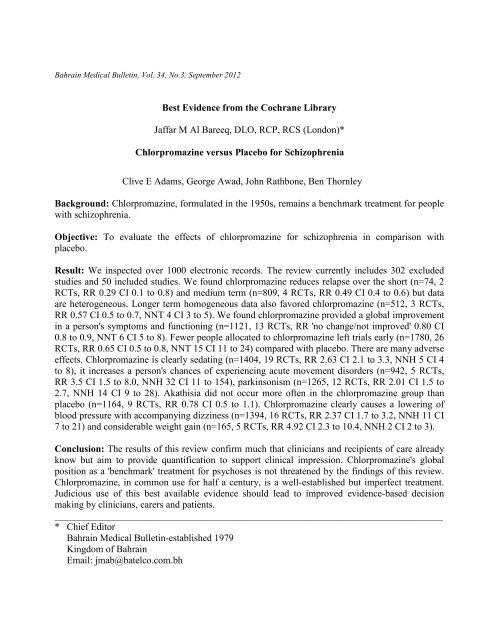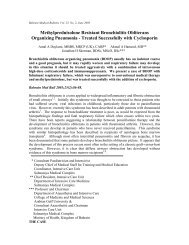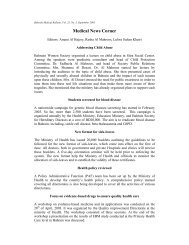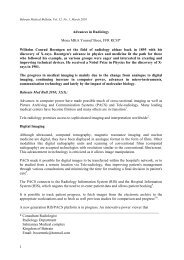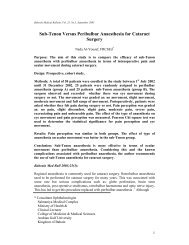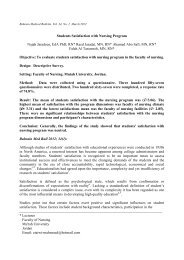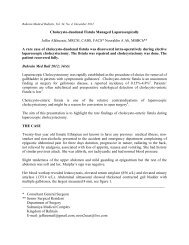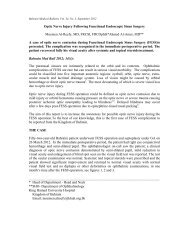Full (125 KB) - Bahrain Medical Bulletin
Full (125 KB) - Bahrain Medical Bulletin
Full (125 KB) - Bahrain Medical Bulletin
Create successful ePaper yourself
Turn your PDF publications into a flip-book with our unique Google optimized e-Paper software.
<strong>Bahrain</strong> <strong>Medical</strong> <strong>Bulletin</strong>, Vol. 34, No.3, September 2012<br />
Best Evidence from the Cochrane Library<br />
Jaffar M Al Bareeq, DLO, RCP, RCS (London)*<br />
Chlorpromazine versus Placebo for Schizophrenia<br />
Clive E Adams, George Awad, John Rathbone, Ben Thornley<br />
Background: Chlorpromazine, formulated in the 1950s, remains a benchmark treatment for people<br />
with schizophrenia.<br />
Objective: To evaluate the effects of chlorpromazine for schizophrenia in comparison with<br />
placebo.<br />
Result: We inspected over 1000 electronic records. The review currently includes 302 excluded<br />
studies and 50 included studies. We found chlorpromazine reduces relapse over the short (n=74, 2<br />
RCTs, RR 0.29 CI 0.1 to 0.8) and medium term (n=809, 4 RCTs, RR 0.49 CI 0.4 to 0.6) but data<br />
are heterogeneous. Longer term homogeneous data also favored chlorpromazine (n=512, 3 RCTs,<br />
RR 0.57 CI 0.5 to 0.7, NNT 4 CI 3 to 5). We found chlorpromazine provided a global improvement<br />
in a person's symptoms and functioning (n=1121, 13 RCTs, RR 'no change/not improved' 0.80 CI<br />
0.8 to 0.9, NNT 6 CI 5 to 8). Fewer people allocated to chlorpromazine left trials early (n=1780, 26<br />
RCTs, RR 0.65 CI 0.5 to 0.8, NNT 15 CI 11 to 24) compared with placebo. There are many adverse<br />
effects. Chlorpromazine is clearly sedating (n=1404, 19 RCTs, RR 2.63 CI 2.1 to 3.3, NNH 5 CI 4<br />
to 8), it increases a person's chances of experiencing acute movement disorders (n=942, 5 RCTs,<br />
RR 3.5 CI 1.5 to 8.0, NNH 32 CI 11 to 154), parkinsonism (n=1265, 12 RCTs, RR 2.01 CI 1.5 to<br />
2.7, NNH 14 CI 9 to 28). Akathisia did not occur more often in the chlorpromazine group than<br />
placebo (n=1164, 9 RCTs, RR 0.78 CI 0.5 to 1.1). Chlorpromazine clearly causes a lowering of<br />
blood pressure with accompanying dizziness (n=1394, 16 RCTs, RR 2.37 CI 1.7 to 3.2, NNH 11 CI<br />
7 to 21) and considerable weight gain (n=165, 5 RCTs, RR 4.92 CI 2.3 to 10.4, NNH 2 CI 2 to 3).<br />
Conclusion: The results of this review confirm much that clinicians and recipients of care already<br />
know but aim to provide quantification to support clinical impression. Chlorpromazine's global<br />
position as a 'benchmark' treatment for psychoses is not threatened by the findings of this review.<br />
Chlorpromazine, in common use for half a century, is a well-established but imperfect treatment.<br />
Judicious use of this best available evidence should lead to improved evidence-based decision<br />
making by clinicians, carers and patients.<br />
________________________________________________________________________________<br />
* Chief Editor<br />
<strong>Bahrain</strong> <strong>Medical</strong> <strong>Bulletin</strong>-established 1979<br />
Kingdom of <strong>Bahrain</strong><br />
Email: jmab@batelco.com.bh
Azithromycin versus Penicillin G Benzathine for Early Syphilis<br />
Zheng Gang Bai, Baoxi Wang, KeHu Yang, Jin Hui Tian, Bin Ma, Yali Liu,<br />
Lei Jiang, Qiong Yan Gai, Xiaodong He, Youping Li<br />
Background: Syphilis is a complex systemic disease caused by a spirochete, Treponema pallidum.<br />
The World Health Organization estimates that at least 12 million people worldwide are currently<br />
infected with syphilis. In this review we compared two current standards of treatment for early<br />
syphilis, benzathine benzyl penicillin (penicillin G) and azithromycin.<br />
Objective: To evaluate the efficacy and safety of azithromycin versus benzathine penicillin<br />
(penicillin G) for early syphilis.<br />
Result: Three studies (generating four eligible study comparisons) were included. One study is<br />
ongoing. There was no statistically significant difference between azithromycin and benzathine<br />
penicillin treatment in the odds of cure (OR 1.04, 95% CI 0.69 to 1.56); nor any difference at three<br />
months (OR 0.97, 95% CI 0.62 to 1.50), six months (OR 1.09, 95% CI 0.76 to 1.54) or nine months<br />
(OR 1.45, 95% CI 0.46 to 6.42). Subgroup analysis by primary and latent syphilis and by dose of<br />
azithromycin (2 g and 4 g) did not explain the variation between the study results. The reporting of<br />
computed mild to tolerated adverse events, from two included trials, indicated no statistically<br />
significant difference between azithromycin and benzathine penicillin (OR 1.43, 95% CI 0.42 to<br />
4.95), although with a high level of heterogeneity (P = 0.05, I 2 = 74%).<br />
Conclusion: Differences in the odds of cure did not reach statistical significance when<br />
azithromycin was compared with benzathine penicillin for the treatment of early syphilis. No<br />
definitive conclusion can be made regarding the relative safety of benzathine penicillin G and<br />
azithromycin for early syphilis. Further studies on the utility of benzathine penicillin G for early<br />
syphilis are warranted.<br />
Crisis Interventions for People with Borderline Personality Disorder<br />
Rohan Borschmann, Claire Henderson, Joanna Hogg, Rachel Phillips, Paul Moran<br />
Background: People with borderline personality disorder (BPD) frequently present to health<br />
services in crisis, often involving suicidal thoughts or actions. Despite this, little is known about<br />
what constitutes effective management of acute crises in this population.<br />
Objective: To review the evidence for the effectiveness of crisis interventions for adults with BPD<br />
in any setting. For the purposes of the review, we defined crisis intervention as ‘an immediate<br />
response by one or more individuals to the acute distress experienced by another individual, which<br />
is designed to ensure safety and recovery and lasts no longer than one month.’<br />
Result: The search identified 15 studies, 13 of which we excluded. Reasons for exclusion were:<br />
lack of randomization (N = 8); retrospective design (N = 2); or the intervention was a complex
psychological therapy lasting longer than one month (N = 3). We identified two ongoing RCTs that<br />
met the inclusion criteria, with a combined predicted sample size of 688. These trials are ongoing<br />
and the results are therefore not included in the review, although they will be incorporated into<br />
future updates.<br />
Conclusion: A comprehensive search of the literature showed that currently there is no RCT-based<br />
evidence for the management of acute crises in people with BPD and therefore we could not reach<br />
any conclusions about the effectiveness of any single crisis intervention. High-quality, large-scale,<br />
adequately powered RCTs in this area are urgently needed.<br />
Ganoderma Lucidum (Reishi Mushroom) for Cancer Treatment<br />
Xingzhong Jin, Julieta Ruiz Beguerie, Daniel Man-yeun Sze, Godfrey CF Chan<br />
Background: Ganoderma lucidum is a natural medicine that is widely used and recommended by<br />
Asian physicians and naturopaths for its supporting effects on immune system. Laboratory research<br />
and a handful of preclinical trials have suggested that G. lucidum carries promising anticancer and<br />
immunomodulatory properties. The popularity of taking G. lucidum as an alternative medicine has<br />
been increasing in cancer patients. However, there is no systematic review that has been conducted<br />
to evaluate the actual benefits of G. lucidum in cancer treatment.<br />
Objective: To evaluate the clinical effects of G. lucidum on long-term survival, tumor response,<br />
host immune functions and quality of life in cancer patients, as well as adverse events associated<br />
with its use.<br />
Result: The methodological quality of primary studies was generally unsatisfying and the results<br />
were reported inadequately in many aspects. Additional information was not available from primary<br />
trialists. The meta-analysis results showed that patients who had been given G. lucidum alongside<br />
with chemo/radiotherapy were more likely to respond positively compared to chemo/radiotherapy<br />
alone (RR 1.50; 95% CI 0.90 to 2.51, P = 0.02). G. lucidum treatment alone did not demonstrate the<br />
same regression rate as that seen in combined therapy. The results for host immune function<br />
indicators suggested that G. lucidum simultaneously increases the percentage of CD3, CD4 and<br />
CD8 by 3.91% (95% CI 1.92% to 5.90%, P < 0.01), 3.05% (95% CI 1.00% to 5.11%, P < 0.01) and<br />
2.02% (95% CI 0.21% to 3.84%, P = 0.03), respectively. In addition, leukocyte, NK-cell activity<br />
and CD4/CD8 ratio were marginally elevated. Four studies showed that patients in the G.<br />
lucidum group had relatively improved quality of life in comparison to controls. One study<br />
recorded minimal side effects, including nausea and insomnia. No significant hematological or<br />
hepatological toxicity was reported.<br />
Conclusion: Our review did not find sufficient evidence to justify the use of G. lucidum as a firstline<br />
treatment for cancer. It remains uncertain whether G. lucidum helps prolong long-term cancer<br />
survival. However, G. lucidum could be administered as an alternative adjunct to conventional<br />
treatment in consideration of its potential of enhancing tumor response and stimulating host<br />
immunity. G. lucidum was generally well tolerated by most participants with only a scattered<br />
number of minor adverse events. No major toxicity was observed across the studies. Although there
were few reports of harmful effect of G. lucidum, the use of its extract should be judicious,<br />
especially after thorough consideration of cost-benefit and patient preference. Future studies should<br />
put emphasis on the improvement in methodological quality; further clinical research on the effect<br />
of G. lucidum on cancer long-term survival is needed. An update to this review will be performed<br />
every two years.<br />
Radiofrequency Ablation in the Treatment of Liver Metastases from Colorectal Cancer<br />
Roberto Cirocchi, Stefano Trastulli, Carlo Boselli, Alessandro Montedori,<br />
Davide Cavaliere, Amilcare Parisi, Giuseppe Noya, Iosief Abraha<br />
Background: Colorectal cancer (CRC) is the most common malignant tumor and the third leading<br />
cause of cancer deaths in USA. For advanced CRC, the liver is the first site of metastatic disease;<br />
approximately 50 % of patients with CRC will develop liver metastases either synchronously or<br />
metachronously within 2 years after primary diagnosis. Hepatic resection (HR) is the only curative<br />
option, but only 15-20% of patients with liver metastases from CRC (CRLMs) are suitable for<br />
surgical standard treatment. In patients with unresectable CRLMs downsizing chemotherapy can<br />
improve resectability (16%). Modern systemic chemotherapy represents the only significant<br />
treatment for unresectable CRLMs. However several loco-regional treatments have been developed:<br />
hepatic arterial infusion (HAI), cryosurgical ablation (CSA), radiofrequency ablation (RFA),<br />
microwave ablation and selective internal radion treatment (SIRT). During the past decade RFA has<br />
superseded other ablative therapies, due to its low morbidity, mortality, safety and patient<br />
acceptability.<br />
Objective: The objective of this study was to systematically review the role of radiofrequency<br />
ablation (RFA) in the treatment of CRLMs.<br />
Result: Seventeen studies were not randomized and this increases the potential for selection bias. In<br />
addition, there was imbalance in the baseline characteristics of the participants included in all<br />
studies. All studies were classified as having an elevated risk of bias. The assessment of<br />
methodological quality of all non-randomized studies included in meta-analysis performed by the<br />
STROBE checklist has allowed us to identify several methodological limits in most of the analyzed<br />
studies. At present, the information from the single RCT included (Ruers 2010) comes from an<br />
abstract of 2010 ASCO Annual Meeting where the allocation concealment was not reported;<br />
however in original protocol allocation concealment was adequately reported (EORTC 40004<br />
protocol). The heterogeneity regarding interventions, comparisons and outcomes rendered the data<br />
not suitable.<br />
Conclusion: This systematic review gathers information from several controlled clinical trials and<br />
observational studies which are vulnerable to different types of bias. The imbalance between<br />
characteristics of patients in the allocated groups appears to be the main concern. Only one<br />
randomized clinical trial (published as an abstract), comparing 60 patients receiving RFA plus CT<br />
versus 59 patients receiving CT alone, was identified. This study showed that PFS was significantly<br />
higher in the group that received RFA. However, it was not able to provide information on overall
survival. In conclusion, evidence from the included studies is insufficient to recommend RFA for a<br />
radical oncological treatment of CRLMs.<br />
Virtual Reality Simulation Training for Health Professions Trainees in<br />
Gastrointestinal Endoscopy<br />
Catharine M Walsh, Mary E Sherlock, Simon C Ling, Heather Carnahan<br />
Background: Traditionally, training in gastrointestinal endoscopy has been based upon an<br />
apprenticeship model, with novice endoscopists learning basic skills under the supervision of<br />
experienced preceptors in the clinical setting. Over the last two decades, however, the growing<br />
awareness of the need for patient safety has brought the issue of simulation-based training to the<br />
forefront. While the use of simulation-based training may have important educational and societal<br />
advantages, the effectiveness of virtual reality gastrointestinal endoscopy simulators has yet to be<br />
clearly demonstrated.<br />
Objective: To determine whether virtual reality simulation training can supplement and/or replace<br />
early conventional endoscopy training (apprenticeship model) in diagnostic<br />
esophagogastroduodenoscopy, colonoscopy and/or sigmoidoscopy for health professions trainees<br />
with limited or no prior endoscopic experience.<br />
Result: Thirteen trials, with 278 participants, met the inclusion criteria. Four trials compared<br />
simulation-based training with conventional patient-based endoscopy training (apprenticeship<br />
model) whereas nine trials compared simulation-based training with no training. Only three trials<br />
were at low risk of bias. Simulation-based training, as compared with no training, generally appears<br />
to provide participants with some advantage over their untrained peers as measured by composite<br />
score of competency, independent procedure completion, performance time, independent insertion<br />
depth, overall rating of performance or competency error rate and mucosal visualization.<br />
Alternatively, there was no conclusive evidence that simulation-based training was superior to<br />
conventional patient-based training, although data were limited.<br />
Conclusion: The results of this systematic review indicate that virtual reality endoscopy training<br />
can be used to effectively supplement early conventional endoscopy training (apprenticeship model)<br />
in diagnostic esophagogastroduodenoscopy, colonoscopy and/or sigmoidoscopy for health<br />
professions trainees with limited or no prior endoscopic experience. However, there remains<br />
insufficient evidence to advise for or against the use of virtual reality simulation-based training as a<br />
replacement for early conventional endoscopy training (apprenticeship model) for health<br />
professions trainees with limited or no prior endoscopic experience. There is a great need for the<br />
development of a reliable and valid measure of endoscopic performance prior to the completion of<br />
further randomized clinical trials with high methodological quality.


